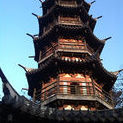Hello, I'm trying to make a bloom effect in my 2D game made with LibGDX. I've a problem with the shader side, in short the glow effect should be go off the bounds of the texture, if I have a texture 40x40 the shader should cover 60x60 for example. This image explain better the problem I have:  , as you can see the bloom effect is cut when the texture ends.
, as you can see the bloom effect is cut when the texture ends.
I suppose that I should modify the default vertex shader to get what I need but I'm not very familiar with GLSL programmig so I ask if someone could help me.
Vertex:
#ifdef GL_ES
precision highp float;
precision highp int;
#endif
attribute vec4 a_position;
attribute vec4 a_color;
attribute vec2 a_texCoord0;
uniform mat4 u_projTrans;
varying vec4 v_color;
varying vec2 v_texCoords;
void main() {
v_color = a_color;
v_texCoords = a_texCoord0;
gl_Position = u_projTrans * a_position;
}Fragment
#ifdef GL_ES
precision highp float;
precision highp int;
#endif
varying vec4 v_color;
varying vec2 v_texCoords;
uniform sampler2D u_texture;
uniform mat4 u_projTrans;
uniform float u_blurSize;
uniform float u_intensity;
void main() {
vec4 sum = vec4(0);
// blur in y (vertical)
// take nine samples, with the distance blurSize between them
sum += texture2D(u_texture, vec2(v_texCoords.x - 4.0*u_blurSize, v_texCoords.y)) * 0.05;
sum += texture2D(u_texture, vec2(v_texCoords.x - 3.0*u_blurSize, v_texCoords.y)) * 0.09;
sum += texture2D(u_texture, vec2(v_texCoords.x - 2.0*u_blurSize, v_texCoords.y)) * 0.12;
sum += texture2D(u_texture, vec2(v_texCoords.x - u_blurSize, v_texCoords.y)) * 0.15;
sum += texture2D(u_texture, vec2(v_texCoords.x, v_texCoords.y)) * 0.16;
sum += texture2D(u_texture, vec2(v_texCoords.x + u_blurSize, v_texCoords.y)) * 0.15;
sum += texture2D(u_texture, vec2(v_texCoords.x + 2.0*u_blurSize, v_texCoords.y)) * 0.12;
sum += texture2D(u_texture, vec2(v_texCoords.x + 3.0*u_blurSize, v_texCoords.y)) * 0.09;
sum += texture2D(u_texture, vec2(v_texCoords.x + 4.0*u_blurSize, v_texCoords.y)) * 0.05;
// blur in y (vertical)
// take nine samples, with the distance blurSize between them
sum += texture2D(u_texture, vec2(v_texCoords.x, v_texCoords.y - 4.0*u_blurSize)) * 0.05;
sum += texture2D(u_texture, vec2(v_texCoords.x, v_texCoords.y - 3.0*u_blurSize)) * 0.09;
sum += texture2D(u_texture, vec2(v_texCoords.x, v_texCoords.y - 2.0*u_blurSize)) * 0.12;
sum += texture2D(u_texture, vec2(v_texCoords.x, v_texCoords.y - u_blurSize)) * 0.15;
sum += texture2D(u_texture, vec2(v_texCoords.x, v_texCoords.y)) * 0.16;
sum += texture2D(u_texture, vec2(v_texCoords.x, v_texCoords.y + u_blurSize)) * 0.15;
sum += texture2D(u_texture, vec2(v_texCoords.x, v_texCoords.y + 2.0*u_blurSize)) * 0.12;
sum += texture2D(u_texture, vec2(v_texCoords.x, v_texCoords.y + 3.0*u_blurSize)) * 0.09;
sum += texture2D(u_texture, vec2(v_texCoords.x, v_texCoords.y + 4.0*u_blurSize)) * 0.05;
gl_FragColor = sum * u_intensity + texture2D(u_texture, v_texCoords);
}








